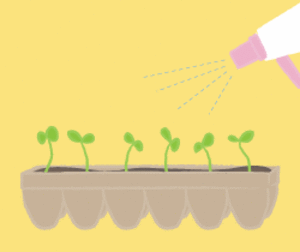News of global warming, rapidly dwindling ocean life, and ever-expanding landfills can leave even the most ardent environmentalist feeling a bit defeated, but in the face of dire statistics it’s important to remember that our actions do make an impact, and every little bit counts. Eco-Cycle, an organization working to build zero waste communities, reports: “Recycling just one aluminum can saves enough energy to operate a TV for 3 hours,” and the California Department of Conservation says if we recycled all of the newspapers printed on a typical Sunday in the U.S., “we would save 550,000 trees–or about 26 million trees per year.”
Small steps initiate big change, and providing children with the necessary tools to safeguard both their personal health and the health of the planet may be the most important education they will ever receive. Building green habits at a young age makes sustainability second nature, giving kids an edge on the older generation who’ve had to wean ourselves from plastic water bottles and gas-guzzling cars the hard way, so get bitten by the sustainability bug and try these fun, educational activities with your kids!
Plant a Seed
Growing and saving seeds is an exciting way to connect children with the process of growing food. Many children (and adults) are woefully under informed when it comes to food sources, and it’s easy to feel disconnected if, in most of our experiences, apples and lettuce reside only in the produce section at the local supermarket.
To cultivate your own piece of food security, purchase seeds from a local seed bank or a similarly responsible source, rather than from the seed rack at Wal-Mart. The Seed Savers Exchange catalog is packed with full color photographs and fascinating descriptions of rare, heirloom varieties, including Dragon Carrots and Tigger Melons, so have fun choosing exotic plants unlikely to grace your supermarket shelves.
When the seeds arrive, be sure to take a moment to read the seed packet or do a quick Internet investigation into the needs of that particular type of seed. Most will germinate readily given a handful of soil, some water, and a sunny windowsill, but it never hurts to check for special requirements.
One example of an inexpensive seed-starting tray is a cardboard egg carton. Cut off the lid and you have twelve ready-made compartments for planting seeds. Look for other recycled options, such as empty produce containers (plastic mushroom boxes work great), the bottom half of a milk carton, or restaurant take out containers. If you can poke a few drain holes in the bottom, most containers can be transformed into a happy home for your new seedlings.
Water your seeds regularly and place them in a sunny spot for faster germination. (A spray bottle on the mist setting makes it easy for small hands to evenly distribute water without drowning small seedlings.) As your plants grow, you’ll want to transplant each seedling to its own pot, and again, look for recycled options in lieu of purchasing new pots. If you have more plants than your space will allow, gift one to a friend and spread the plant love. For more information, check out Fun Ways to Cultivate Biodiversity in the Garden.
Get Wiggly With It
Most children have a fascination with wiggly critters, and worms are an excellent way to explore the benefits of healthy soil and the ways in which we can protect this valuable resource. Vermicomposting, or composting with worms, provides kids with an opportunity to watch worms at work, transforming ordinary kitchen scraps into nutrient rich worm castings, which make an excellent addition to potting mixes and garden soil.
Combine vermicomposting with the seed planting activity outlined above, and your worm bin will act as an excellent source of natural fertilizer for your seedlings.
Worm composting can be carried out in even the smallest of urban spaces, so clear out an under-sink cabinet or basement shelf and get ready to compost! A wooden or plastic bin, no more than a foot deep with drainage holes drilled into the bottom, is the perfect home for your worms. For detailed instructions on setting up a worm bin, including selecting the right worms and proper feeding tips, read Vermicomposting: How to Compost With Worms.
‘Tis the Season
Fresh strawberries in January? Year-round bananas? These, and other supermarket mainstays, have served to destroy any conception of seasonal produce for most American shoppers, yet the cost of shipping food from more temperate climates is staggering, and with ever-rising fuel costs, now more than ever, a tomato traveling 1,500 miles to grace our mid-winter salads is a wasteful extravagance.
Barbara Kingsolver, author of Animal, Vegetable, Miracle: A Year in Food Life, coined the term “vegetannual” to describe an imaginary plant that bears a progression of vegetables over the course of one growing season, giving an excellent approximation of what’s in season when. (Check out the vegetannual by visiting the Animal, Vegetable, Miracle website.)
To redefine your children’s sense of seasonal foods, try this fun activity. Divide a piece of poster board into four quadrants: Spring, Summer, Fall and Winter. Using old seed catalogs or gardening magazines, cut and paste fruits and vegetables into the appropriate seasonal category (or draw your own) for a beautiful visual guide to in-season eating. Expand your food base to include locally produced cheeses, nuts, pasture-raised meats, etc., all valuable foodstuffs, particularly in the leaner winter months. Alternatively, print up free calendar templates and tailor this activity for each month. Calendars make a great gift for family and friends who might benefit from a little seasonal guidance themselves!
Once you’ve educated yourself on the local options, hit the farmer’s market and get to know the people who are growing food in your community. Inquire about Community Supported Agriculture (CSA) memberships. Many farms offer a discount in exchange for volunteered time, another great way for kids to have fun while gaining experience on a working farm.
Reference:
- www.greenkids.com/
- www.kidsrgreen.org/krg.html
- kids.nationalgeographic.com/Stories/SpaceScience/Green-tips
